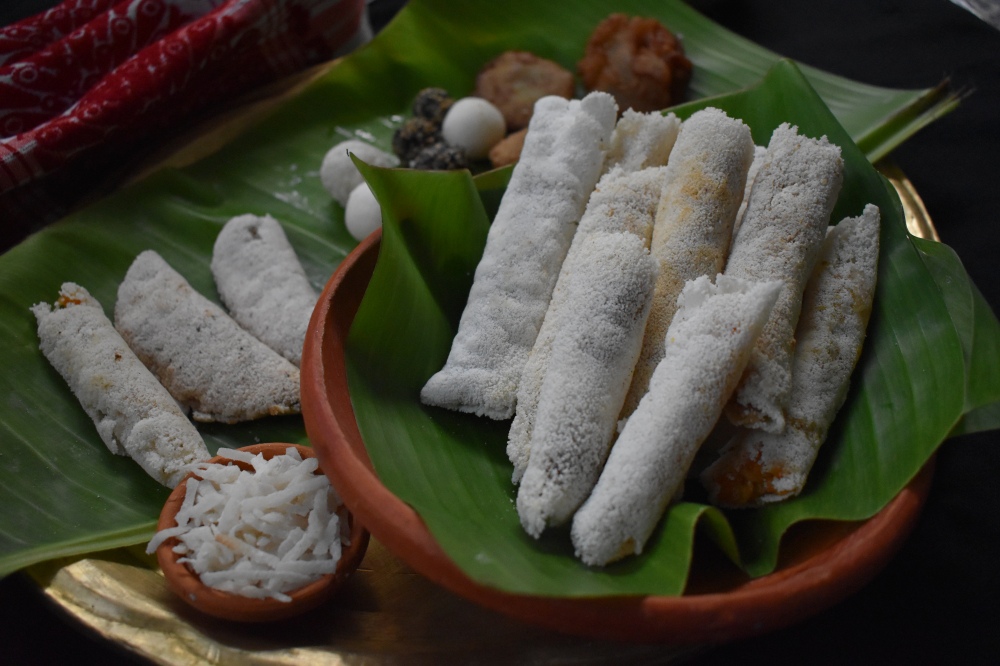
Time just flies and we keep on running with it. It’s been a year that I have shared my previous post of Makar Sankranti and the time for making merriment is here yet again when people are exhilarated on celebrating the first harvest festival of the year. Last year I had posted Tekeli pitha of Assam and this time again, I want to share with you another exotic Assamese pitha from the treasure of flavours in Northeast India.
Magh bihu or bhogali bihu, the festival of feasting in Assam which coincides with Lohri, Poush parbon, makar sankranti, uttarayan, pongal or bhogi elsewhere in India is a significant harvest festival that truly defines assamese culture, and most importantly defines what assamese cuisine is all about. The 3-7 days feasting extravaganza starts right away with the dinner feast known as Uruka or the elaborate dinner spread comprising of aloo pitika, daali, bhaji, khar, mas (fish), mangkho(meat) and payokh( rice pudding), which is entirely cooked with firewood amidst get together of extended family members, relatives or friends. The merrymaking in front of fire, in front of the food being cooked, the smell and cosy warmth of firewood, amidst singing and dancing is what makes the festival so alluring. The mejis or bhelaghars which are the straw or thatch huts made for the occasion are burnt early in the morning after taking bath to offer prayers to fire god. After burning of mejis, another round of daylong feasting starts with the jolpaan or breakfast, which obviously has to be a indispensable part of the traditional assamese bhogali bihu platter comprising of an assortment of pitha(s) like til pitha, ghila pitha, laru, sitol pitha, hurum, akhoi, doi, gur, seera and lot more. Since most of them are sweet, they are sometimes accompanied with savoury pancakes, puri bhaji, savoury gujiyas or samosas. However the star of this platter which is the most important of all and which vouches for one of the many uniqueness of assamese cuisine is the Til pitha.
These pithas are very popular here in Assam, and can be found any time round the year, and is a quintessential component of Assamese bihu platter that are served along with other sweets and pithas for feasting. It is a kind of sweet dry rice pancake which is totally oil free, prepared from a type of glutinous rice called bora saul in Assam (a unique rice variety available in Assam, northeast India and Bangladesh), where in the grounded rice is rolled around sesame seeds or sometimes coconut filling sweetened and flavoured with jaggery. This rice based confectionery is one of the healthiest sweet available in India and world and preparing these pithas require skillful hands as rolling of this pancake requires artistic acumen. These pithas have a very unique & interesting texture which is crunchy, crispy and little chewy on outside that very well complement with its moist, crunchy, sweet filling inside. The taste of it slightly varies from freshly prepared to the packed or stored ones i.e. the crispness decreases gradually when you keep it for two to three days. However, it tastes great in both forms and you are never going to forget it once you have it. A til pitha with a hot cup of tea is enough to make you happy & refreshed at any time. Since the traditional form of til pitha is prepared with til ( sesame seeds ) & gur ( jaggery ) as stuffing, the name of this dish came to be known as til pitha but funnily the coconut version is also called Til pitha😊.
This is one of my most favourite pithas, so crazy ideas do run in my mind for filling this pitha with anything that I would like and you may also allow your imagination to fill it inside with just any stuffing that you find suitable keeping in mind that the filling should not be too moist to break off or crumble the rice pancakes. I have tried with different ingredients for stuffing like nolen gur (date palm jaggery), coconut, khoya/mawa, orange flavoured carrots, sweetened bottle gourd and the final outcome was really not bad. Usually these til pithas are mildly sweet with healthy fillings inside, but for some foodie like us, health always takes a back seat when it comes to enjoying the taste of anything so my fillings are little heavy on the sweet side.
Til pithas are always loved & enjoyed in my family and since it is quite a healthy option, there are no guilt or regrets. So, try this out at least once who haven’t yet & it is surely going to win your heart. I think I left you overloaded…not dragging it more…lets jump to the recipe below👇
RECIPE:
Ingredients :
1. For Rice coat :
A) Sticky Rice ( Assamese bora saul/Bengali birun chaal or Manipuri black rice (finely grounded ) or any form of sticky rice – 500 gms
2. For fillings : ( Vegans can skip the use of khoya in stuffing )
A) For Khoya filling :
i) Khoya/mawa – 1/2 cup
ii) Coconut (grated) – 1/2 cup
iii) Date palm jaggery (nolen gur/khejur gur) – 1 to 1&1/2 tbsp
B) For Orange flavoured filling :
i) Orange pulp – 1 orange
ii) Orange zest -1/4th tsp
iii) Carrot (grated) – 2 tbs
iv) Coconut (grated) – 2 tbs
v) Sugar – 4 tsp appxly. according to the sweetness of the orange.
C) For Bottle gourd halwa filling :
i) Finely chopped Bottle Gourd/lauki/lao – 1and1/2 cup
ii) Sugar – 2 tbs
iii) Coconut (grated) – 1/2 cup
iv) Khoya – 1 tbs
v) Rose water – 1/2 tsp
Preparation :
1. For Rice coat :
i) Soak the bora saul or sticky rice in water for 4-5 hours or over night.
ii) Drain the water completely and let it dry for 30 to 60 mins by spreading it over a piece of paper.
iii) After the rice is dried, grind it in a grinder into a fine powder.
Note: The key to a perfect pitha mainly involves two things, one is the moisture of the ground rice and another is the temperature of the tawa/pan while making your pithas.
To check whether your rice powder is perfect or not, take a small amount of the powder in your palm and press it gently to make a clump. If the clump doesn’t crumble back when you release it from your palm, then your flour is okay otherwise you have to sprinkle few drops of water to make it little moist.
iv) After your rice powder is ready, press it a little and store it in a container covered with a wet cloth and close the lid tightly so that the moisture is retained in the flour till you use it for making pithas.
2. For Fillings :
A) For Khoya filling :
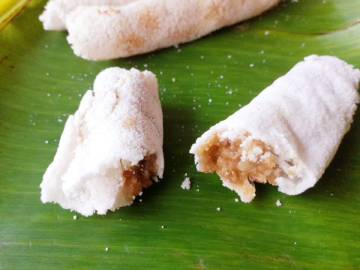
i) Melt your jaggery in a pan with little water, put it over a low flame and keep stirring.
ii) Add the khoya to melt and mix with the jaggery nicely .
iii) Add coconut and keep on stirring to condense it little more and switch off the flame when the mixture just starts leaving the sides of your pan. Don’t overdo, otherwise your khoya mixture will get hardened. Your khoya filling is ready for use.
B) For Orange flavoured filling :
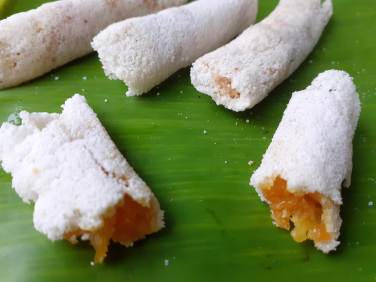
i) Rub the orange zest with the sugar that you will use for filling. This will enhance the flavour of orange in your mixture.
ii) Melt this rubbed sugar in a pan with little water over a low flame by stirring in the mixture.
iii) Add grated carrots and coconut to the mixture and keep on stirring for 3 to 4 minutes to cook the carrots.
iv) Add orange pulp and continue to stir.
v) When the mixture leaves the sides of the pan, switch off the flame.
vi) Keep the mixture in a closed container to retain the flavour of orange and let it cool down completely before use.
C) For Bottle gourd halwa filling :
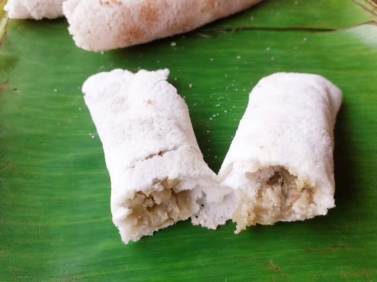
i) Finely chop your bottle gourd and keep it aside.
ii) In a pan, melt sugar with little water over a low flame and keep on stirring.
iii) When the syrup turns little thick, add your chopped bottle gourd and mix.
iv) Continue to stir the mixture till the water in the gourd gets dried completely. This step may take some time as the water content of gourd is more and it may take more time to dry off completely.
v) After the mixture is dry enough, add khoya, grated coconut and mix well.
vi) Keep stirring the mixture until it leaves the sides of your pan.
vii) Add rose water, mix and switch off the flame.
viii) Bring it down from your stove and let it cool.
All your three fillings are ready for making pithas.
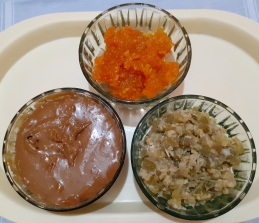
3. For making your pitha :
i) Take your prepared rice flour over a strainer and sieve it.
ii) Put the tawa over a low flame and heat it slightly so that you just start feeling its warmth when you bring your palm over the tawa.
Note : This is the most crucial step in making this pitha , if the tawa doesn’t reach the particular temperature, the flour will not bind properly and your pitha will get cracked. Also, higher temperature will cause the rice flour to splatter and you won’t be able get your perfect pithas. So, my suggestion to you is first try making the first one and then you will able to determine the right temperature.
iii) Now, take the rice flour in a ladle and spread it over the tawa uniformly either with the back of your ladle or by using your fingers.
Note : Spread the flour uniformly and avoid making it thick or else the coat will get cracked while folding.
iv) Put the filling at the centre and with the help of a fork or knife raise the side and then start folding very gently from one side using your fingers to make tight rolls.
v) Keep it aside over the tawa itself for sometime and start making your next pitha in a similar way.
vi) Serve your crispy pithas fresh from the tawa and enjoy its crunch in every bite or store them in air tight containers for 2-3 days for serving or having them later for a quick bite when hungry. Serve them for your breakfast or snack over a hot piping cup of tea.
Note: You may refer to the slide show below for the steps of folding the pitha.👇
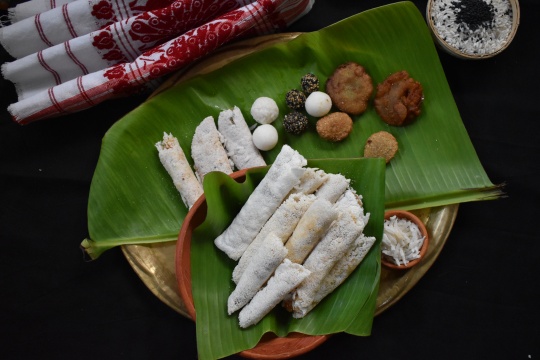

You replied to this comment.
LikeLiked by 1 person
Really glad that you have gone through the post so minutely…thanks a lot…please do try it once and let me know🙂
LikeLiked by 1 person
Til pitha recipe or information degia
LikeLiked by 1 person
Please see our blog post on til pitha at http://www.foodiestreasure.com…you will get the recipe as well information there.
LikeLike
Never tried this before. But loving it 🤗
LikeLiked by 1 person
Thank you….Do try once …you’ll surely love it😊
LikeLiked by 1 person
Great recipe, beautifully executed! These pitha look so divine, only a skilful hand can make such a delicate roll. Thank you so much for sharing this traditional recipe.
LikeLike
Thank you so so much.. & you are welcome !!..😊
LikeLiked by 1 person